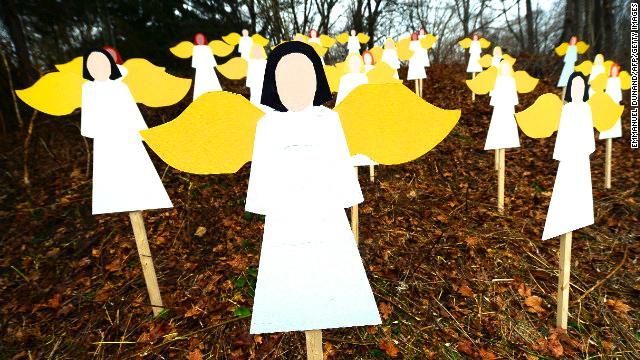
Shortly after last Thanksgiving, I was asked to write a piece about 2012, the year just ending.
I got as far as the title and the first sentence, then gave up because I thought I was wandering too far into the fields of metaphor for my own good and for the good of the essay itself. The title I gave the unborn essay was “The Hemorrhaging of America.” I thought of it this weekend when I read the news that Adam Lanza, a gunman in Connecticut, opened fire and killed 20 elementary school children, plus eight adults including his mother, Nancy Lanza, who taught at Sandy Hook Elementary School. Lanza had killed his mother before he took her car and drove to the school, where according to reporters he choose his victims and killed them “with brutal efficiency.”
According to reports from rural Newton, Connecticut, Ms. Lanza owned the weapons – semi-automatic pistols and semiautomatic rifles – that her son used to slaughter 28 people, mostly six and seven-year-olds. The school psychiatrist and the school principal, who were close by when Mr. Lanza shot his way into the building, were also killed. Many of the children were riddled with multiple bullets, shot at point-blank range. The whole event reads like a symbolic tale for Christmas: a killer named Adam and a town named Newton – how more American could any story be?
In the wake of the massacre it’s hard to know what to say that might be helpful, though I can think of a lot of things to say including, “I knew it was going to happen,” “I called it,” “A nation that lives by the gun dies by the gun,” and “America is as violent as cherry pie.” It’s hard to avoid clichés such as that last one, attributed to H. Rap Brown, a black militant in the 1960s, now serving a life sentence for shooting two Fulton County sheriff’s deputies, one of whom died. For a time, Brown, who was born Hubert Gerold Brown and who wrote an autobiography entitled Die Nigger Die!, wanted a violent revolution in America. Like many would-be violent revolutionaries, Brown found that the state was a lot more powerful than he realized.
The comments that I considered are clichés, I know, but that doesn’t discount them. Clichés contain kernels of truth. I did intuit that there would soon be another outburst of violence. One doesn’t have to be a psychic or clairvoyant to know that a killer is capable of striking any day, anywhere. Guns do kill people, though loyal National Rifle Association (NRA) members insist that “guns don’t kill people, people kill people.”
As long as Americans can buy guns legally and fairly easily over the counter, Americans will kill other Americans and kill themselves, too. Like many other assailants, Mr. Lanza turned a weapon on himself and pulled the trigger. News stories reported that he “committed suicide.” I would say that he added his own body to the pile of corpses. The same stories reported that the authorities had no idea what Mr. Lanza’s motives might have been.
Too bad the school psychiatrist isn’t alive and can’t help to identify the killer’s motives. I know that’s a cruel, sardonic comment but I couldn’t resist making it. In the wake of the tragedy, tears are appropriate, but so is the cold light of reason. It seems to me that we don’t really need psychiatrists. We might need sociologists and historians who can illuminate the social and historical roots of the slaughter in Newton, Connecticut, not far from the site where English colonists slaughtered hundreds of Indian men, women, and children in a bloodbath in 1637, almost four hundred years ago. The American novelist James Fenimore Cooper wrote in his 1827 novel The Last of the Mohicans that the “soil” itself was “fattened with human blood.”
American soil has been fattened with human blood from the very beginning. American playgrounds, classrooms, and college campuses have been fattened with blood, too. The first slaughter on a college campus that I know of took place in and around the Tower at the University of Texas on August 1, 1966, when Charles Whitman, an engineering student and former U.S. Marine, opened fire, killing 13 people, including an unborn child, and wounding 32 others. I went to the tower not long ago and surveyed the scene. It had been closed for years and was reopened to visitors such as myself and the woman who accompanied me and who had been a student at UT, where Whitman’s name is still remembered. The UT Tower still haunts me.
Ending the four hundred plus years of violence on American soil will not be easily achieved and it will not happen overnight. Americans are too devoted to violence and guns to break their addictions to them in one suddenly change of heart. At the least, however, what we might now do, immediately, is act to abolish all weapons in every school, college, and university in the U.S., and to make it impossible to bring weapons to any campus or school. Can we at least make schools safe havens for students, parents, and teachers? Can we please take guns away from sons such as Adam Lanza and from mothers such as Nancy Lanza, and can we begin to see that violence is a deep-seated American family value that very much needs to be cleansed non-violently and as humane possible.
Jonah Raskin is the author of "The Radical Jack London" and biographies of Abbie Hoffman and Allen Ginsberg.
3 WAYS TO SHOW YOUR SUPPORT
- Log in to post comments











